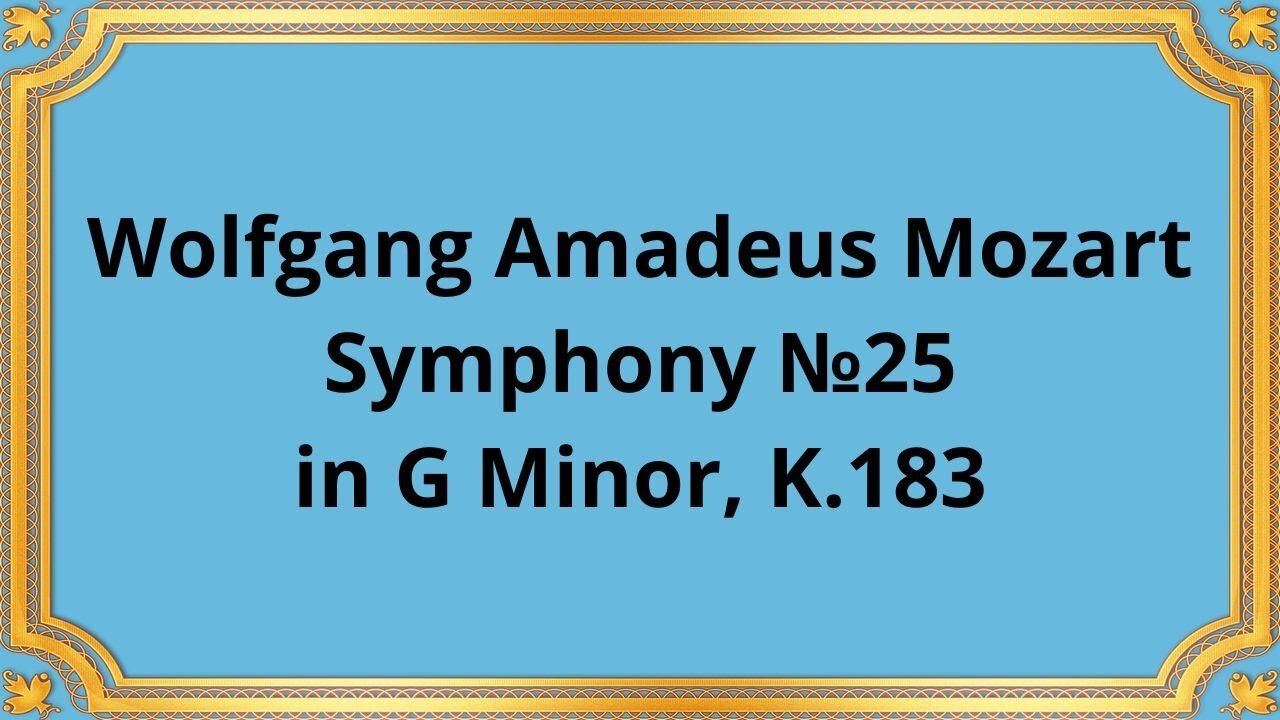Premium Only Content

Wolfgang Amadeus Mozart Symphony №25 in G Minor, K.183
#classicalmusic #Mozart #chambermusic #symphony #WolfgangAmadeusMozart #SymphonyNo25 #ClassicalMusic #MusicalComposition #Composer #Symphony #GMinor #OnlineVisibility #AudienceReach
Publication date 1961
Pro Musica Orchestra conducted by
OTTO KLEMPERER
Wolfgang Amadeus Mozart, a prodigious composer of the classical era, gifted the world with a vast array of extraordinary musical compositions. Among his many masterpieces, Symphony No. 25 in G Minor, K.183, stands out as a testament to his unmatched talent and innovation.
Composed in 1773, Symphony No. 25 in G Minor holds a significant place in Mozart's early symphonic output. The composition emerged during a tumultuous period in Mozart's life, marked by personal and professional unrest. At the tender age of 17, Mozart crafted a symphony that showcased his maturity as a composer and foreshadowed the depth of his musical genius.
Mozart's Symphony No. 25 adheres to the traditional four-movement structure of a classical symphony: Allegro con brio, Andante, Menuetto, and Allegro. Through these movements, Mozart takes listeners on a captivating musical journey.
Allegro con brio: The opening movement immediately captivates with its dark and intense atmosphere. The symphony unfolds with gripping urgency, showcasing Mozart's ability to create dramatic tension through powerful melodies and dynamic contrasts.
Andante: The second movement transitions into a more serene and introspective mood. Here, Mozart demonstrates his gift for crafting poignant melodies, evoking emotions of melancholy and longing. The movement showcases his ability to convey depth and sensitivity through delicate orchestration and expressive harmonies.
Menuetto: The third movement injects a sense of elegance and grace into the symphony. Marked by its triple meter, the Menuetto offers a delightful dance-like quality, providing respite from the emotional intensity of the previous movements. Mozart's meticulous attention to detail shines through in the intricate interplay between the various sections of the orchestra.
Allegro: The final movement returns to the fiery energy of the opening, bringing the symphony to a thrilling climax. Mozart's exceptional command of form and orchestration is on full display here. The movement is characterized by its virtuosic passages and exhilarating rhythmic drive, leaving listeners captivated until the final triumphant notes.
Mozart's Symphony No. 25 in G Minor has left an enduring impact on the world of classical music. Its dark and dramatic character, combined with its technical brilliance, has solidified its place as one of Mozart's most revered symphonic works.
Furthermore, Symphony No. 25 has served as a source of inspiration for subsequent generations of composers. Its innovative use of harmonies, melodic development, and orchestration has influenced countless musical compositions across different genres.
Conclusion:
In conclusion, Mozart's Symphony No. 25 in G Minor, K.183, is a testament to his prodigious talent and remarkable musical vision. Its historical context, distinct musical characteristics, and lasting significance underscore Mozart's unparalleled contributions to the world of classical music. This symphony stands as a testament to Mozart's ability to evoke profound emotions, captivate audiences with his musical storytelling, and leave an indelible mark on the rich tapestry of musical composition.
You have the opportunity to support the channel:
https://destream.net/live/RadSiarAl/donate
https://www.buymeacoffee.com/6355radsiaral
-
 6:07
6:07
Classical music_Music Inspiration
8 days agoJoseph Haydn Piano Sonata in D Major, Hob. XVI:51
361 -
 LIVE
LIVE
tacetmort3m
1 day ago🔴 LIVE - SOLO RANK GRINDING CONTINUES - MARVEL RIVALS
1,527 watching -
![Shadows Of Chroma Tower, Alpha Playtest [Part 1]](https://1a-1791.com/video/fwe2/1d/s8/1/5/Q/U/n/5QUnx.0kob-small-Shadows-Of-Chroma-Tower-Alp.jpg) 13:29:21
13:29:21
iViperKing
19 hours agoShadows Of Chroma Tower, Alpha Playtest [Part 1]
125K5 -
 54:05
54:05
TheGetCanceledPodcast
17 hours ago $13.20 earnedThe GCP Ep.11 | Smack White Talks Smack DVD Vs WorldStar, Battle Rap, Universal Hood Pass & More...
120K19 -
 13:37
13:37
Exploring With Nug
21 hours ago $8.02 earnedSUV Found Underwater Searching For Missing Man Jerry Wilkins!
80.6K4 -
 2:58:21
2:58:21
xBuRnTx
16 hours ago1st Warzone Stream Online
74.6K7 -
 6:10:21
6:10:21
JdaDelete
1 day ago $21.52 earnedDino Crisis - Sega Saturday
148K5 -
 23:22
23:22
MYLUNCHBREAK CHANNEL PAGE
1 day agoUnder The Necropolis - Pt 5
117K59 -
 2:26:11
2:26:11
Jewels Jones Live ®
2 days agoWINNING BIGLY | A Political Rendezvous - Ep. 108
169K50 -
 2:04:49
2:04:49
Bare Knuckle Fighting Championship
4 days agoBKFC FIGHT NIGHT MOHEGAN SUN FREE FIGHTS
91.1K7